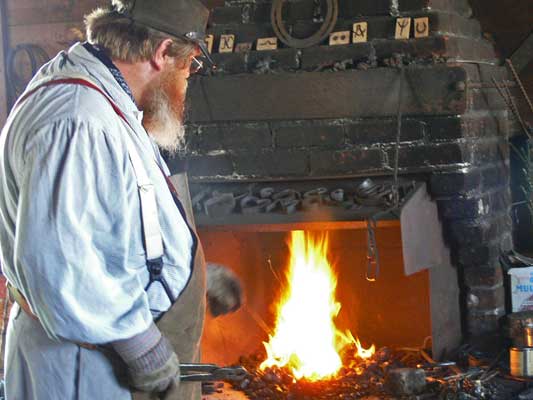Last updated: December 5, 2024
Lesson Plan
Who Was a Blacksmith?

- Grade Level:
- Upper Elementary: Third Grade through Fifth Grade
- Subject:
- Social Studies
- Lesson Duration:
- 60 Minutes
- Common Core Standards:
- 6-8.WHST.1, 6-8.WHST.2
- Additional Standards:
- NCSS Standard 2.C.
NCSS Standard 4.A.
NCSS Standard 4.B. - Thinking Skills:
- Remembering: Recalling or recognizing information ideas, and principles. Analyzing: Break down a concept or idea into parts and show the relationships among the parts. Evaluating: Make informed judgements about the value of ideas or materials. Use standards and criteria to support opinions and views.
Essential Question
What skills and jobs are essential for human survival?
Objective
Students will be able to:
• Explain a blacksmith and their importance to communities
• Describe the types of objects and tools blacksmiths made
• Learn about craftspeople and others whose work in the 21st century would be similar to that of the blacksmith
• Describe the work cowboys and ranch hands learned after 1900 regarding metal when no blacksmiths were around
• Connect students’ personal experiences using, repairing or repurposing objects and tools
Background
Blacksmiths, people who worked over a forge and crafted tools and objects out of iron, were essential to the society of the 19th century. Before factories were using mass production methods to quickly make and sell large quantities of metal items, it was the blacksmith who crafted these items. Everything was made by hand in a blacksmith shop, and to become a blacksmith took years of hard work. By 1900, the blacksmith profession was disappearing as factories and catalogs made ordering manufactured goods easy and cheaper. Ranchers also began purchasing the goods they needed through mail order catalogs, and with the expansion of railroads across the West, it was easier to get their orders in a more timely manner. The blacksmith profession was revived during the Great Depression, when the lack of money made purchasing new items difficult, and many people needed to fix what they owned. The skill of working in iron and metal was in demand, and people looking for work turned to old blacksmiths to learn their skills. Cowboys and ranch hands had to learn how to repair broken tools and other metal objects critical to their jobs, such as wagon parts, mechanical equipment for tractors and trucks, as well as turning pieces which could not be fixed into other useful items. Repurposing and recycling were essential to survival on ranches, and nothing went to waste. Today, while blacksmithing is not a profession most people would find in their towns, there are many careers who do similar work to what the blacksmith did in the 19th century.
Preparation
• The Grant-Kohrs Ranch NHS Repair Shop Virtual Visit video
• Copies of the student worksheet – Who was a Blacksmith?
Materials
Download Who Was A Blacksmith? Student Worksheet
Lesson Hook/Preview
Introduction 5 minutes
Activate student’s prior knowledge by asking them if they have ever had to repair something that broke. What was it? Were they successful? If not, what did they do with it? Throw it away or find a new use for it? How easy was it to replace if they could not fix it? In the 19th century, if the item that broke was made of metal, it might go to the blacksmith to be fixed. Blacksmiths were a key member of a community because they had the skill to create or fix metal tools and objects which people needed in their daily lives.
Procedure
Video 28 minutes
Watch the Repair Shop Virtual Field Trip video found on the Grant-Kohrs Ranch NHS Education website. This video is approximately 28 minutes long.
Discussion 5 minutes
Review and discuss several key topics presented and demonstrated in the video, including the importance of a blacksmith in a community, as well as the different skills which they needed to do their job. Why did the profession of blacksmithing start to disappear? Who started to do that job after 1900? How did they learn the skills they needed to work with metal?
Student Activity 20 minutes
Students now know more about blacksmiths, cowboys, and how these two professions combined after 1900. Students will answer the questions on their worksheet. There are a variety of jobs today who work to fix and repair objects or who build and create new objects. This could include engineers, architects, repair people, artisans and craftspeople, welders, mechanics (auto, tractors, and more), factory workers, handymen, and many other careers.
Vocabulary
Merriam-Webster Dictionary definitions
• Blacksmith - a smith who forges iron
• Blacksmith alternate definition from the Collins Dictionary – a blacksmith is a person whose job is making things by hand out of metal that has been heated to a high temperature
• Forge - a furnace or a shop with its furnace where metal is heated and wrought
• Cowboy - one who tends cattle or horses
• Great Depression - the period of severe worldwide economic decline that began in 1929 and lasted throughout the 1930s and that was marked by deflation and widespread unemployment
• Repurpose - to give a new purpose or use to
• Recycle – to pass again through a series of changes or treatments: such as to process (something, such as liquid body waste, glass, or cans) in order to regain materials for human use
Assessment Materials
Who Was a Blacksmith? Student WorksheetStudent worksheets can be used for assessment. The accuracy of their historic facts as well as the evidence of students making connections between the blacksmith’s and cowboy’s work in the past with careers in the 21st century reflect what students have learned from the video and activity.
Additional Resources
For More Information
Arnold, Oren and John P. Hale. Hot Irons: Heraldry of the Range. New York: Cooper Square Publishers, Inc. 1972.
Bealer, Alex W. The Art of Blacksmithing. New York: Funk and Wagnalls. 1976.
